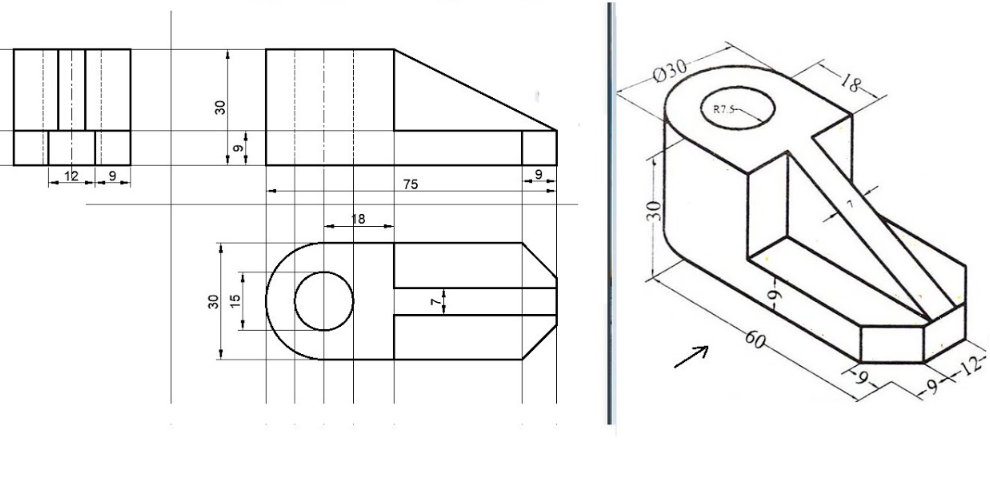The front view is frequently one of the most identifiable aspect of a technical drawing. It gives the most informative point of view of an object, recording its height and size while obscuring deepness. This view is typically the initial drawing to be created and acts as the recommendation point for establishing added views. The main objective of the front view is to supply a clear, simple representation of the item that emphasizes important features, measurements, and proportions. This sight stabilizes the drawing procedure, allowing developers to work from this standard perspective, making sure that subsequent views straighten correctly which all featuresline up as intended.
Structure upon this, the top sight complements the front view by giving info concerning the depth of the things. This view enables developers to see exactly how wide and deep the item is, removing ambiguity that might arise from the preliminary façade alone. The top view aids to visualize partnerships between different aspects of the layout, making it easier to comprehend the design of parts, especially in elaborate systems with lots of overlapping components. When utilized efficiently, the leading sight can help communicate vital facets of capability and spatial arrangement that are important for producing and setting up.
The profile, also known as the profile view, uses yet an additional viewpoint by depicting the object's height and depth. It is especially beneficial for showcasing attributes that might not be as obvious in the front or leading views. By incorporating the side view into the technical drawing, designers guarantee that all dimensions can be precisely provided, producing a thorough sight of the things. In addition, the side view can highlight contours, slopes, or any protrusions that may be significant to the design's operational efficacy and aesthetic appeal.
Discover technical drawing views the important role of technical drawing in design and design, highlighting crucial views such as front, top, side, area, and isometric point of views that make sure exact interaction and implementation in style and production.
Section views are an additional crucial element of technical drawings. They offer a way to show the inner functions of a style that might not be apparent from the exterior views. A section view is created by slicing through the object and revealing its interior geometry.
Another useful method in technical drawing is isometric projection. This sight uses a three-dimensional representation of the object, giving a practical illusion of depth and range without needing complex perspective estimations. Isometric views can be exceptionally advantageous in conveying the total design of an object, specifically to individuals who might not be skilled in reviewing technical illustrations. While isometric forecasts drop brief of representing real point of view, they remain a preferred option for presenting concepts clearly and not surprisingly. When responses and iterative renovation are essential, this makes them specifically helpful throughout the very early design phases.
In addition to these fundamental views, there are different other kinds of estimates, such as orthographic and viewpoint projections, that serve different functions in technical drawing. Orthographic forecasts are a collection of numerous views that independently portray the object from different angles, normally in a two-dimensional layout.

To efficiently create a technical drawing, it is vital to comprehend the conventions and signs that stand for various attributes and measurements. Engineers and engineers use various lines-- such as solid lines, dashed lines, and centerlines-- to communicate info concerning sides, attributes, and vital areas. Dimensioning is another crucial component of technical drawing. Appropriate dimensioning offers essential measurements that determine just how parts mesh, ensuring that designs meet necessary tolerances and specifications. Incorrect dimensions can result in expensive errors during manufacturing, making this aspect of technical drawing important for dependability and success.
A number of software application tools and applications facilitate the technical drawing procedure, boosting the standard hand-drawing techniques. These tools make it possible for very easy adjustments, enabling for rapid prototyping and iteration without the demand to recreate illustrations from scratch.
In the context of sectors today, recognizing exactly how to apply various views in technical drawing is not only crucial for designers and architects yet likewise for manufacturers, item designers, and also marketing professionals. In collaborative settings, particularly in areas like building and production, clear technical drawings ensure that all stakeholders-- from developers to clients-- are on the exact same page.
The ability to from detailed technical illustrations, including several views, is crucial for creating components that not only fit together properly yet also operate effectively as component of broader systems. Furthermore, as sectors transition to computerized and electronic processes, the skills required to generate and interpret technical drawings will certainly be critical to future skill pipes.
In conclusion, technical drawing encompasses numerous views, each of which plays a details duty in sharing needed info regarding an item. As innovation and approaches for creating technical drawings proceed to breakthrough, understanding and carrying out these views successfully stays critical. As we move further into a period identified by fast technological evolution, the principles of technical drawing and its associated views will most certainly continue to be crucial in forming the future of style, engineering, and manufacturing.